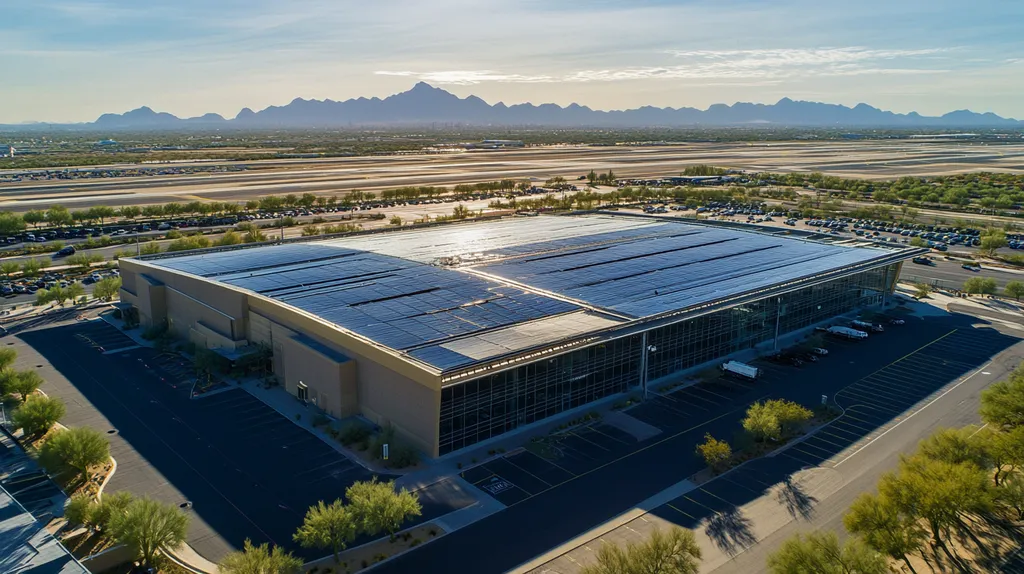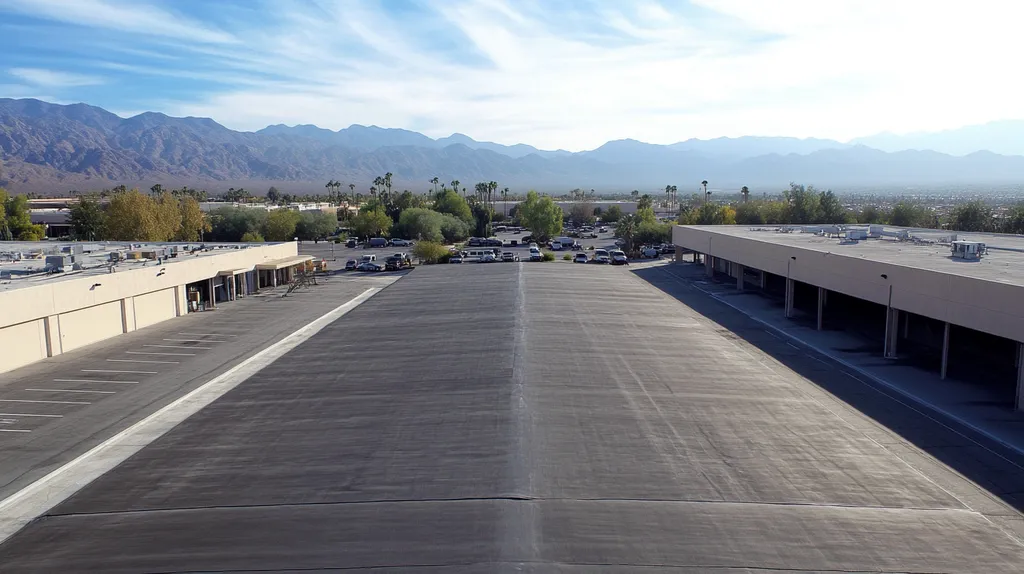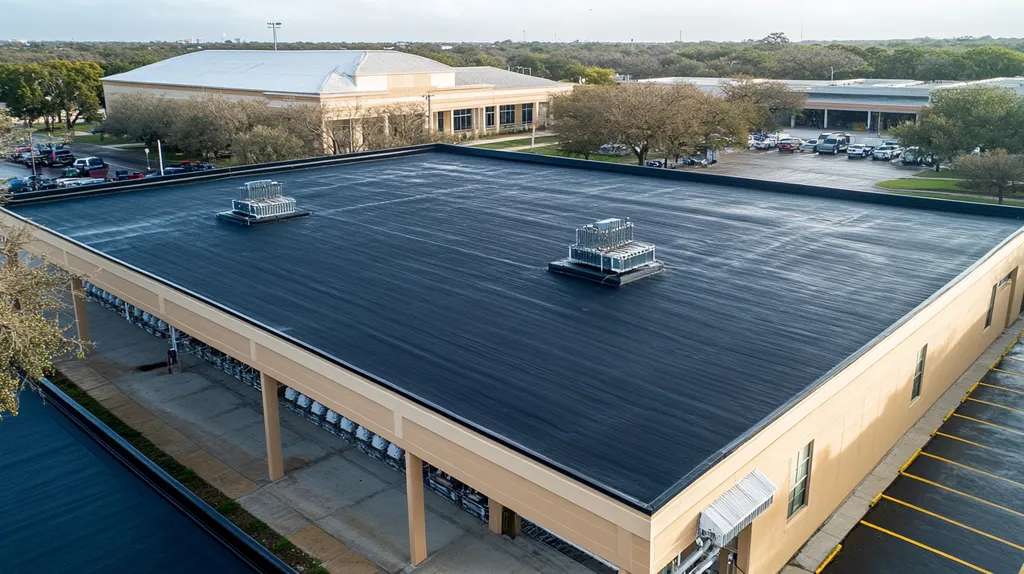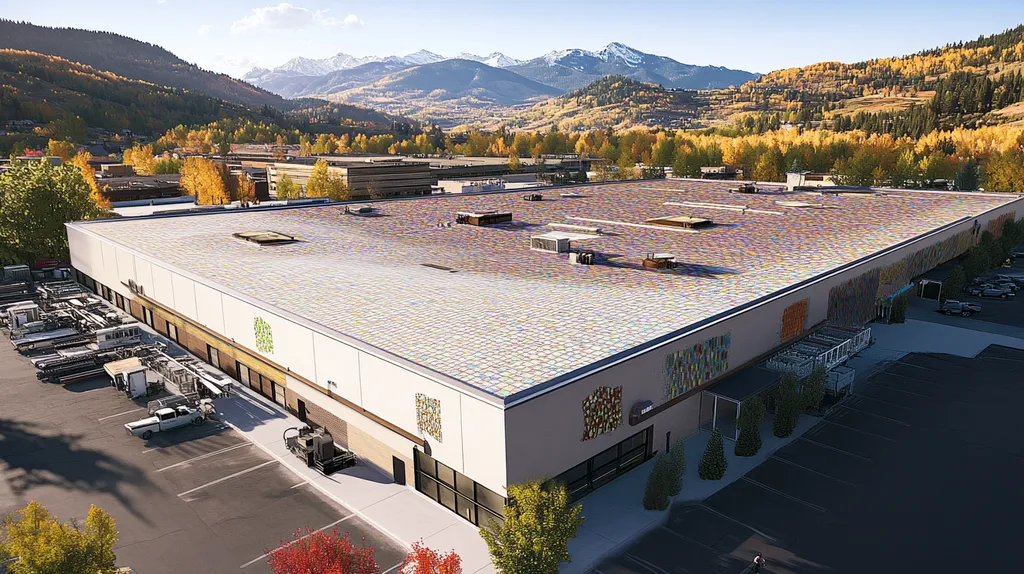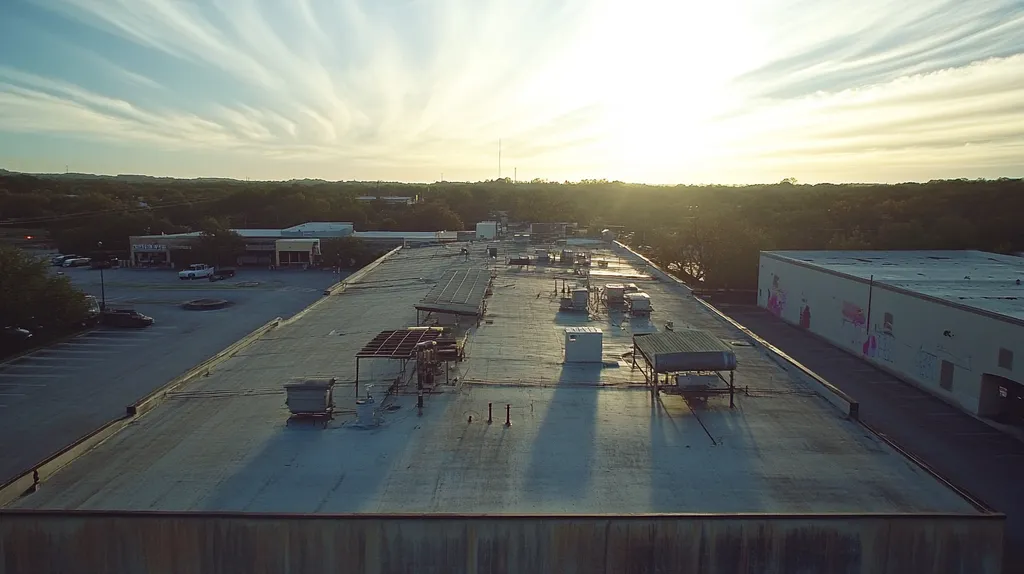Commercial roofs are responsible for up to 40% of a building’s total energy loss, costing facility managers millions in preventable expenses each year. Without proper maintenance routines, even minor inefficiencies can compound into major financial and environmental impacts.
From degraded insulation to compromised ventilation systems, identifying and addressing these issues requires a systematic approach focused on performance, compliance, and risk management.
This comprehensive guide provides facility managers with actionable solutions to maximize roof efficiency through proven maintenance protocols, financial optimization strategies, and long-term planning considerations.
SECTION 1: PERFORMANCE FACTORS
For facility managers, grasping the performance factors that affect commercial roof efficiency is not just important—it’s essential. A poorly performing roof can dramatically inflate energy costs, diminish occupant comfort, and accelerate the deterioration of the building’s structure. Alarmingly, the U.S. Department of Energy estimates that up to 30% of a building’s energy escapes through its roof. By proactively addressing insulation integrity, selecting reflective materials, and ensuring proper ventilation, significant gains in energy efficiency can be achieved. This section delves into these critical factors in detail.
Insulation Integrity and R-Value
The integrity of a roof’s insulation plays a pivotal role in energy efficiency. Insulation R-value, which measures the material’s resistance to heat flow, directly impacts how well a building retains temperature. A higher R-value signifies better thermal resistance, which means less reliance on heating and cooling systems.
For instance, roofs with inadequate insulation often result in higher energy expenditures due to heat escaping in the winter and excess heat entering during summer months. Regular inspections to evaluate insulation condition and R-values are vital for preserving roof efficiency.
Aging or compromised insulation might necessitate upgrading or replacement. Attending to insulation concerns swiftly can potentially save property owners up to 25% in annual energy costs.
Furthermore, during roof replacements or upgrades, facility managers should prioritize the installation of high-R-value insulation materials. This not only enhances energy savings but can also extend the lifespan of the roofing system.
Key Action Items
Reflective Roofing Materials and Coatings
Utilizing reflective roofing materials is crucial for maximizing roof efficiency and reducing unwanted heat absorption. For example, light-colored or white membranes effectively reflect sunlight, keeping buildings cooler, especially in hotter climates.
Studies indicate that reflective roofing can lower roof surface temperatures by as much as 70 degrees Fahrenheit compared to conventional dark surfaces. This, in turn, can significantly decrease cooling expenses and improve indoor comfort.
Moreover, applying reflective coatings to existing roofs enhances performance and energy efficiency without undergoing a complete roof replacement. This approach is not only budget-friendly but also profoundly beneficial for energy savings.
Still, facility managers must be discerning; not all reflective materials are equally effective. It’s essential to assess reflectivity ratings and energy efficiency certifications when selecting materials or coatings to guarantee optimal performance.
Key Action Items
Ventilation and Air Leakage
Proper ventilation is vital for a well-functioning roofing system. Effective ventilation manages moisture levels and prevents heat accumulation in the attic space, safeguarding roof integrity.
Conversely, air leakage can undermine the advantages gained from insulation and reflective materials. Even small gaps or unsealed penetrations can cause considerable energy loss. Research shows that inadequate sealing can diminish energy efficiency by as much as 30% over time.
Establishing a maintenance protocol that includes inspecting for air leaks and evaluating ventilation systems is a proactive strategy to bolster energy efficiency. Regular visual inspections can pinpoint areas needing attention.
Additionally, facility managers should explore extra ventilation options, such as ridge vents or soffit vents, to enhance airflow. Improved ventilation not only regulates temperature more effectively but also prolongs the life of the roofing system.
Key Action Items
SECTION 2: FINANCIAL CONSIDERATIONS
Maximizing the energy efficiency of a commercial roof is not just beneficial for the environment; it is also essential for financial health. With rising energy costs, facility managers must be vigilant about their roofing systems. The U.S. Department of Energy estimates that effective roof maintenance can lead to energy bill reductions of up to 30%. Understanding the financial implications—ranging from energy savings to maintenance costs and tax incentives—can empower facility managers to make informed decisions that benefit both their budgets and the planet.
Energy Cost Savings and ROI
Energy efficiency is closely linked to financial savings, making it a priority for facility managers. A well-designed roofing system enhances insulation, which effectively lowers heating and cooling costs. Simple maintenance practices, including regular inspections and timely repairs, can yield up to 20% savings on energy expenses.
Staying vigilant about roof conditions is essential; even minor issues can snowball into significant energy losses if neglected. Additionally, opting for energy-efficient materials, including reflective coatings, can profoundly impact long-term savings.
The return on investment (ROI) should not be overlooked. A well-maintained, energy-efficient roof not only cuts costs but can also elevate the property’s market value. When planning budgets, it’s crucial to integrate potential energy savings to assess overall ROI effectively.
Key Action Items
Maintenance and Repair Expenses
Regular maintenance is vital for managing expenses associated with commercial roofing. Without consistent upkeep, small issues can escalate into major repairs that significantly impact the budget. Routine tasks, such as clearing gutters and inspecting seams, can greatly diminish the risk of costly emergency repairs.
Failing to maintain can lead to leaks and structural damage, compounding repair costs. For example, a minor puncture can develop into a considerable problem, disrupting operations and resulting in expensive fixes.
Establishing a proactive maintenance schedule helps facility managers anticipate and budget for these costs effectively. Investing in professional maintenance services may seem like a significant initial outlay, but it often translates into lowered repair needs and enhanced roof lifespan.
Key Action Items
Tax Incentives for Energy Efficiency
Tax incentives play a crucial role in improving the financial landscape of maintaining a commercial roof. Many governments provide benefits for property owners investing in energy-efficient roofing solutions, ranging from tax credits to deductions that lessen the financial burden of initial investments.
Such tax programs encourage the implementation of energy-saving technologies. Facilities upgrading their roofing systems can access substantial savings, enhancing their overall financial viability. Staying up-to-date on local and federal regulations is vital to fully capitalize on these potential benefits.
Facility managers should consult tax professionals to uncover available credits for energy-saving initiatives. Strategic tax planning can turn investments in energy efficiency into profitable ventures while advancing sustainability objectives.
Key Action Items
SECTION 3: COMPLIANCE REQUIREMENTS
Compliance with local building codes and regulations is vital for enhancing the energy efficiency of commercial roofs. Ignoring these requirements can lead to hefty fines and potential legal troubles. Property owners and facility managers must remain vigilant about changes in regulations and standards that apply to roofing systems.
Local Building Codes and Regulations
Local building codes govern various aspects of roofing installations and renovations, including acceptable materials, safety standards, and insulation criteria. Following these codes is not merely a legal necessity; it’s instrumental for ensuring the long-lasting performance of the roof. Many codes undergo frequent updates, incorporating the latest advances in energy efficiency and safety.
Scheduling regular inspections to verify compliance can save significant costs down the line. Facility managers should prioritize these inspections at strategic intervals, allowing them to identify and resolve compliance issues proactively.
Additionally, some local governments offer incentives for adopting energy-efficient roofing practices. Being aware of these incentives can enhance a facility’s operational budget. Engaging with local authorities early in project planning can also streamline the permitting process.
Key Action Items
Energy Efficiency Standards and Certifications
Energy efficiency standards set by organizations like the Environmental Protection Agency (EPA) and the Department of Energy (DOE) are crucial for the performance enhancement of commercial roofs. Meeting these standards typically results in noticeable reductions in energy use and operational costs. Facilities that comply can benefit from improved performance ratings and marketability.
Certifications such as Energy Star and LEED showcase a commitment to sustainable practices. Achieving these certifications requires thorough evaluations that can attract environmentally conscious clients and investors. For instance, roofs certified by Energy Star can lead to lower cooling costs.
Remaining informed about energy efficiency standards empowers facility managers to select appropriate materials and techniques. Implementing energy-efficient roofing solutions can significantly reduce overall energy consumption, ultimately boosting property values.
Key Action Items
Environmental Impact Compliance
Environmental considerations are increasingly important for commercial roofing projects. Regulations often require a thorough assessment of a roof’s impact on local ecosystems and communities. Overlooking these requirements can lead to negative environmental and economic repercussions.
Facilities that emphasize environmental compliance can enjoy reduced emissions and improved relationships with their communities. This responsible approach resonates with tenants and stakeholders who prioritize sustainability. For example, opting for recyclable and sustainable materials can greatly minimize a building’s ecological footprint.
Moreover, adherence to environmental compliance can enhance financing opportunities. Lenders are often more willing to support projects demonstrating sound environmental strategies. Regular audits of roofing materials can ensure compliance with environmental regulations and highlight areas for improvement.
Key Action Items
SECTION 4: RISK MANAGEMENT
Effective risk management is crucial to ensuring the longevity and efficiency of commercial roofs. Neglecting roofing issues can lead to leaks and water damage, which drastically increase repair costs and threaten the structural integrity of the building. Additionally, facility managers must address heat-related problems that can overload HVAC systems. Proactive management of these risks is vital for maintaining safety, energy efficiency, and financial stability.
Identifying and Mitigating Leaks and Water Damage
Water damage is a common issue that can have devastating effects on commercial roofs. Even small leaks can escalate rapidly, leading to structural damage and unsafe conditions. Routine inspections are essential for spotting potential problem areas before they worsen.
Focus on inspecting flashings, seams, and joints as they are critical points for leak detection. Areas subject to severe weather or heavy foot traffic require special consideration. Utilizing infrared technology during inspections can effectively reveal moisture hidden underneath the roofing surface.
Once leaks are found, addressing them immediately is necessary to prevent further complications. Establishing a robust maintenance schedule will not only tackle current problems but also help prevent new ones from developing.
Key Action Items
Preventing Heat-Related Issues and HVAC Overload
Roofing heat-related issues can lead to undue strain on HVAC systems, resulting in wasted energy and increased expenses. The commercial roof plays a vital role in regulating building temperatures, especially under extreme weather conditions. An unprotected rooftop can absorb unwanted heat, thus overworking HVAC systems.
Regular assessments are necessary to verify that roofing materials effectively reflect sunlight. Utilizing energy-efficient coatings or reflective membranes can significantly reduce heat absorption and enhance the building’s overall energy efficiency.
Proper insulation placement is also crucial in minimizing heat-related problems. Ensuring adequate ventilation within the roofing design allows airflow, thus reducing overheating and prolonging the life of HVAC systems.
Key Action Items
Ensuring Structural Integrity and Safety
Maintaining the structural integrity of a commercial roof is essential for upholding safety standards. Regular inspections and assessments can uncover underlying problems before they become safety hazards. Conditions like sagging or cracking can jeopardize the roof’s stability, posing risks to both property and personnel.
After severe weather events, it is crucial to conduct immediate inspections to assess potential damage. Failures in roofing structures may lead to catastrophic situations, including collapses or hazardous debris being dislodged.
Routine maintenance checks should encompass comprehensive evaluations of the roof’s support structure, materials, and load capacity. Reinforcements or upgrades may be required for older buildings to comply with modern safety standards.
Key Action Items
SECTION 5: OPERATIONAL PROCEDURES
Implementing solid operational procedures is vital for maintaining the energy efficiency of commercial roofs. Neglecting these practices could result in costly repairs, excessive energy waste, and a shortened lifespan for roofing materials. Research shows that improperly maintained roofs can lead to a staggering 30% increase in cooling costs. This section outlines essential procedures, including regular inspections, maintenance schedules, and staff training, to ensure your roof performs at its best.
Regular Inspection and Audit Protocols
Conducting regular inspections is key to spotting problems before they turn into costly repairs. Facility managers should perform visual inspections every six months, looking for signs of wear, leaks, or debris. An annual, detailed audit using thermal imaging is essential to assess insulation efficiency and identify hidden issues that could impact performance.
Documentation is vital. Maintaining logs of all inspections helps managers track recurring problems and measure the success of corrective actions. Utilizing management software can streamline inspection scheduling and documentation processes.
Regular examination of roof drainage systems is equally important. Clogged gutters and downspouts can lead to standing water, increasing the risk of leaks and damage. Incorporating cleaning these systems into inspection routines safeguards roof performance and longevity.
Key Action Items
Scheduled Maintenance and Repair Schedules
Creating a robust maintenance schedule is essential for preventing potential roofing failures. Seasonal tasks like resealing seams, checking fasteners, and assessing vegetation growth must be part of routine maintenance. This proactive approach can prolong the life of the roof and improve its energy efficiency.
Addressing repairs quickly after inspections can save substantial costs down the line. Minor issues that are ignored often escalate into major expenses and increased energy use due to inadequate insulation or leaks.
Facility managers should also create a timeline for significant renovations. Typically, roofs require complete replacement every 20 to 30 years, but diligent maintenance can extend this timeline. Evaluating the return on investment for repairs assists in justifying budget allocations for ongoing roof care.
Key Action Items
Training for Facility Maintenance Personnel
Training maintenance personnel is crucial for ensuring operational protocols are executed consistently and effectively. Training sessions should encompass inspection techniques, safety protocols, and roof-specific knowledge. Providing staff with the skills to identify early signs of distress can significantly mitigate risks.
Incorporating energy efficiency training is equally important and can yield significant cost savings. Staff needs to understand how their actions affect the roof’s thermal performance and energy consumption. Proper management of insulation and ventilation during repairs can lead to better energy metrics.
Ongoing education through workshops or online courses keeps staff updated on industry best practices and technologies, enhancing maintenance strategies. Regular performance evaluations help identify training gaps and opportunities for improvement, strengthening the focus on energy efficiency as a team goal.
Key Action Items
SECTION 5: OPERATIONAL PROCEDURES
Implementing effective operational procedures is crucial to the energy efficiency of commercial roofs. Neglecting these practices can result in costly repairs, wasted energy, and a reduced lifespan for roofing materials. Research indicates that poorly maintained roofs can lead to up to a 30% increase in cooling costs. This section highlights the importance of regular inspections, maintenance schedules, and comprehensive training for staff to ensure optimal roof performance.
Regular Inspection and Audit Protocols
Routine inspections are vital for identifying potential problems before they become expensive repairs. Facility managers should conduct visual evaluations at least twice a year, searching for signs of wear, leaks, or debris accumulation. Annual in-depth audits, which include thermal imaging assessments, are important for evaluating insulation efficiency and uncovering hidden issues that may affect performance.
Documentation is essential for tracking maintenance activities. Keeping detailed inspection logs helps managers identify recurring issues and measure the effectiveness of interventions. Utilizing management software can simplify the scheduling and logging process, enhancing accountability.
Moreover, consistent examination of roof drainage systems is necessary. Clogged gutters and downspouts can cause standing water, increasing the risk of leaks and structural damage. Regularly adding cleaning these systems to inspection routines fosters proactive protection of the roof.
Key Action Items
Scheduled Maintenance and Repair Schedules
Establishing a well-structured maintenance schedule is crucial for preventing roofing failures. Seasonal tasks such as resealing seams, checking fasteners, and managing vegetation growth should be part of routine maintenance. This proactive approach helps extend the roof’s life while improving energy efficiency.
Addressing repairs promptly after inspections can lead to significant cost savings over time. Ignoring minor issues often results in major expenses, including increased energy consumption due to inadequate insulation or leaks.
Additionally, facility managers should set timelines for major renovations. While roofs typically need complete replacement every 20 to 30 years, diligent maintenance can lengthen this timeline and enhance energy savings. Evaluating the return on investment for existing repairs informs budget allocation for ongoing maintenance.
Key Action Items
Training for Facility Maintenance Personnel
Proper training for maintenance personnel is essential to ensure that operational procedures are executed efficiently. Training sessions should cover inspection techniques, safety protocols, and specific roof types. Equipping staff with the knowledge to identify early signs of distress can significantly reduce risks.
Incorporating energy efficiency training is equally important, leading to substantial cost savings. Personnel should be aware of how their actions influence the roof’s thermal performance and overall energy consumption. For instance, managing insulation and ventilation effectively during repairs can significantly enhance energy metrics.
Regular engagement in ongoing education through workshops or online courses helps maintain staff expertise and keeps them informed about industry advancements. Conducting periodic performance evaluations identifies training gaps and opportunities for improvement, fostering a team-focused approach to energy efficiency.
Key Action Items
Moving Forward
With commercial roofs responsible for up to 40% of building energy losses, facility managers can no longer afford to neglect comprehensive maintenance routines.
The data is clear: proper insulation maintenance alone can reduce energy costs by 25%, while reflective coatings can lower roof temperatures by 70 degrees Fahrenheit.
Success requires a systematic approach incorporating regular inspections, preventive maintenance, and staff training focused on energy efficiency best practices.
As energy costs continue rising and environmental regulations become stricter, investing in roof maintenance is not just about immediate savings – it’s about ensuring long-term building sustainability and compliance.
The tools, technologies and expertise exist today to dramatically improve commercial roof performance through proper maintenance protocols.
FREQUENTLY ASKED QUESTIONS
Q. What performance factors affect a commercial roof’s efficiency?
A. Key performance factors include insulation integrity, material reflectivity, and ventilation. Ensuring these elements are in optimal condition prevents energy loss and maintains occupant comfort. Regular inspections can reveal weaknesses, helping to enhance overall efficiency.
Q. How can energy-efficient commercial roofs save money?
A. By lowering heating and cooling expenses, energy-efficient roofs can reduce energy bills up to 30%. Additionally, investing in efficient materials can lead to significant long-term savings, boosting property value and promoting sustainability.
Q. What are the compliance requirements for an industrial roof?
A. Compliance includes adhering to local building codes and energy efficiency standards. Regular inspections verifying these criteria are essential to avoid penalties and ensure proper performance. Engaging with local authorities can maximize benefits during renovations.
Q. How can I prevent leaks on my commercial roof?
A. Conducting routine inspections focused on flashings and seams can identify potential leak points. Immediate repairs of discovered leaks and a proactive maintenance schedule will help prevent water damage and extend the roof’s lifespan.
Q. What maintenance routine is essential for energy efficiency of commercial roofs?
A. A robust maintenance routine includes scheduled inspections, timely repairs, and regular cleaning of drainage systems. Establishing these practices keeps roofs in prime condition and significantly contributes to long-term energy efficiency.
Q. How does training staff improve the efficiency of commercial roofs?
A. Training staff in roof inspection techniques, safety protocols, and maintenance practices equips them to identify issues early. This proactive approach minimizes risks and enhances the energy efficiency of the roofing system over time.
Q. What innovative technologies can enhance commercial roof efficiency?
A. Technologies like thermal imaging for inspections and energy-efficient coatings can greatly improve insulation and energy savings. Implementing these innovations ensures roofs are effective in reducing operational costs while promoting sustainability.

